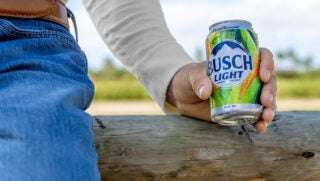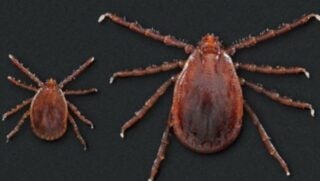I’ve been writing about agriculture for years, but aquaculture has been uncharted waters for me (pun intended).
So when I had a chance to visit the largest Aquaculture Stewardship Council certified shrimp farm in South America, I jumped at the opportunity.
Nestled about an hour outside of Ecuador’s largest city, Guayanquil (which is home to about 2 million people), is S.O.N.G.A. — Sociedad Nacional de Galápagos C.A., a shrimp processing facility in a protected area that processes more than 600,000 pounds of shrimp per day from around 20,000 acres of local farms.
Since aquaculture was an area I knew little about, I wasn’t sure what to expect. Social media comments like this one below and articles about how you should never buy foreign seafood swirl the internet, but are the food fears worthy of a worry?

Like I always say: Go to the source. So here we go!
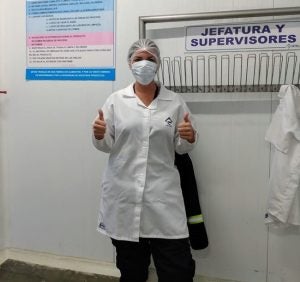
The photo above is me geared up to go inside the freezer area of the factory, which employs near 1,500 people. Similar to efforts of large-scale livestock farms, biosecurity is a big part of ensuring the highest food-safety standards — making sure you don’t bring in any bacteria or anything else detrimental from the outside. The farmers pride themselves on a stock density of shrimp (22 to 25 per square meter in aerated ponds), while using no antibiotics.
We geared up and walked through a foot bath with our rubber boots. My overall impression was that the food-safety standards of this Ecuadorian shrimp processing facility had regulations comparable to (or maybe even better!) than U.S. standards. The United State is one of their biggest export markets, after all (along with China and other parts of Asia).
Eighty-five percent of the shrimp processed here are raw with the heads on, but for people like me who prefer the headless, cooked, bagged, and easy to use shrimp, there’s a market for that here, too. They have many other value-added products that are exported around the world.
They’re unloaded from local farms in bins weighing 800 pounds, with labels showing where they came from — total traceability. Next, samples from each bin are taken to chemical and microbiology laboratories, where they’re tested and inspected for color, taste, sulfite levels, nitrogen, etc. Shrimp are killed via ice quickly through hypothermia and are inspected numerous times for size, quality, defects, and more.
Should defects be found, those shrimp are separated and ground for other types of animal feed, along with the heads of the headless product.
And that’s the other thing. We all see peeled shrimp processed with no heads or tails, but did you know that’s all done BY HAND? Workers here in the factory are very skilled at this and get paid based on how many pounds they harvest. Each worker is suited up in a warm uniform (since they work in freezers all day!) with an employee number and tag to be tracked. Once they process a bin, their tag is scanned by management and put into the computer system.
The process of screening, auditing, cleaning, sorting, testing, cooking, weighing, tracing, and packaging is a very thorough and impressive one! Whether packaged for commercial use in brine or IQF (Individual Quick Frozen) or whatever else the market demands, shrimp are then stored in several different ways of freezing. They even go through a metal detector. As guests in the plant, we had to change our clothes three times to walk through different areas. Quality assurance and food safety are clearly important.
As far as the farming aspect goes, shrimp farmers must track everything they do on the farm or else they cannot get paid. I was pleasantly surprised to learn they don’t use antibiotics, but they may use molasses/probiotics in the water to promote the good bacteria. Shrimp arrive on the farm from the hatchery around 20 days of age and will be on the farm for about 90 more days until they go to market. This is what the ponds look like:
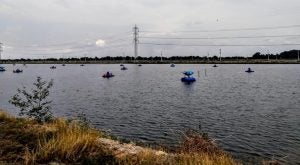
Here you see equipment that aerates the pond (adds oxygen) and some feeders, which can be automatic and solar powered!
Fun fact: Shrimp make tiny little noises when they’re hungry, and the feeders use hydrophones that can sense it and automatically throw feed into the water, which is made of soy, fish oil, and other fish/tuna byproduct.
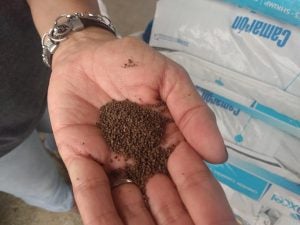
The color and flavor of shrimp can be related to the water and soil, which are monitored, tested, and recycled.
The ponds will be drained when it’s time to harvest … but here, the workers took some out of the pond so I could see and hold them.
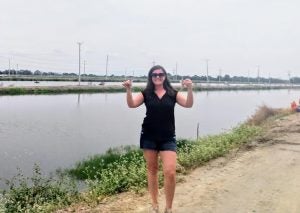
So are the “foreign food fears” warranted? I can’t speak to how it’s done in other countries, but in this instance, I definitely say no. And I have zero problems looking for the “raised in Ecuador” label. I always like to support my local American farms first, of course, but it’s important to get the facts: Foreign farms can do just as good of a job and are needed to feed the world.
A big thanks to my friends at S.O.N.G.A. for the education and transparency!
Michelle Miller, the Farm Babe, is an Iowa-based farmer, public speaker, and writer, who lives and works with her boyfriend on their farm, which consists of row crops, beef cattle, and sheep. She believes education is key in bridging the gap between farmers and consumers.

